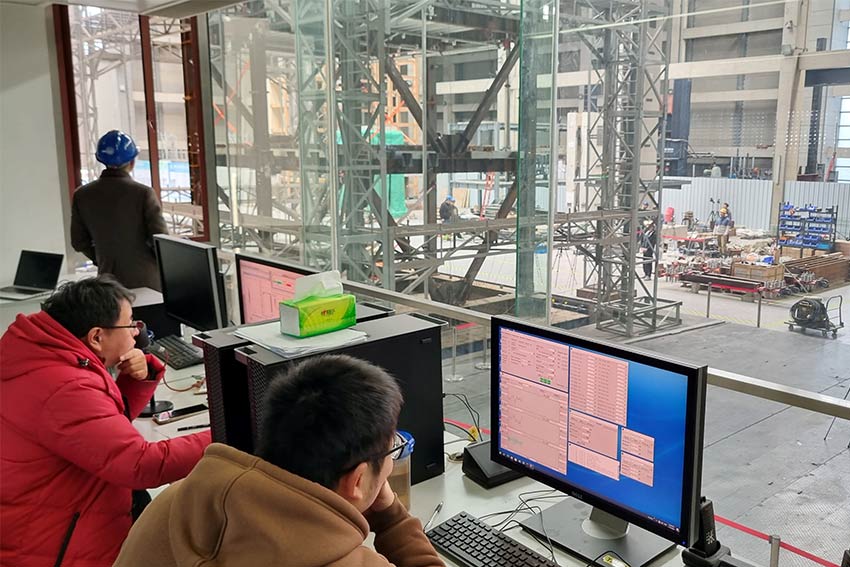Earthquake innovations tested in China

Pioneering seismic engineering research by AUT Associate Professor Shahab Ramhormozian and his collaborators was put to the test in one of the world’s biggest earthquake laboratories.
The work has delivered stunning results and endorsements for engineering solutions by Dr Ramhormozian and other New Zealand and Chinese researchers.
The shake table at the International Laboratories for Earthquake Engineering (ILEE), at Tongji University in Shanghai, allows real-life earthquake testing on real-scale multi-storey buildings, Dr Ramhormozian says.
With the support of EQC Toka Tū Ake and other New Zealand research agencies, engineers worked closely with their Chinese counterparts to test a variety of innovations on the shake table as part of the ROBUST (Robust Building Systems) project.
“The ROBUST project involved testing a three-storey, nine-metre-tall and eight-by-five-metre plan building, with friction-sliding energy dissipators – used to dissipate earthquake energy in buildings - in nine different forms and configurations,” Dr Ramhormozian says.
In the last stage of the tests, non-structural elements were also added to the building. These included external cladding, internal partition walls, ceilings and sprinkler piping, plus interior furniture like tables, chairs, and shelves with books.
All the components, including energy dissipators, withstood shakings well beyond those of the Canterbury earthquakes.
The ROBUST project results will feed the $8.2 million MBIE-funded grant, ‘Sustainable Earthquake Resilient Buildings for a Better Future,’ that Dr Ramhormozian received in 2022, in collaboration with academic and industry partners nationally and internationally.
One of the solutions tested in the ROBUST shake table series was the sliding hinge joint (SHJ) connections initially developed by Professor Charles Clifton in late 1990s, and later improved by Dr Ramhormozian, who received the Ivan Skinner award by EQC in 2022 to fine-tune this transformational building connection.
Dr Ramhormozian’s improved system is called the Optimised Sliding Hinge Joint (OSHJ).
The OSHJ is used by engineers in New Zealand and its concept is adopted abroad, but Dr Ramhormozian says the rigorous testing in Shanghai, on a real-scale building incorporating structural and non-structural components, is an important endorsement for the engineering world.
“We know that these new solutions work, but we could never test them in New Zealand to the level we have been able to in China,” he says.
“For engineers and building developers, this gives confidence that these connections will withstand the intense earthquake shaking that we experience in Aotearoa.”
The final shake of the ROBUST building involved a peak ground acceleration of 0.88g (g=gravitational acceleration) in each direction simultaneously – significantly larger than the 0.55g recorded in the 22 February 2011 Christchurch earthquake.
Even with this level of shaking, Dr Ramhormozian says the structure incorporating OSHJs in a longitudinal direction, friction braces adopting the OSHJ design philosophy, and all non-structural elements, performed very well.
“The ROBUST test results also allow us to modify and improve our building analysis and to design tools and procedures that are as realistic as practicable. Research into making these improvements is being undertaken by PhD student Gholamreza Hashemi,” Dr Ramhormozian says.
He says the ROBUST results also provide insights into where more testing and simulations at component levels needs to be done.
“This will help to ensure the systems we are developing are well tested, and their associated design parameters are well quantified before being implemented in practice,” he says
“These are the research topics of PhD student Fatemeh Alizadeh, and Post Doctoral Research Fellow Dr Zhenduo Yan at AUT.
“Dr Yan’s PhD, under Professor Charles Clifton and myself was, for several years, focused on design and detailing of the ROBUST project’s building,” Dr Ramhormozian says.
EQC Toka Tū Ake Head of Research Dr Natalie Balfour says ROBUST is a great example of how funders with different vested interests can come together to enable world-leading research.
“EQC is particularly interested in how this research can lead to more earthquake-resilient buildings. Some of the technology being tested through ROBUST is already in use in buildings across Aotearoa, so it’s important to understand how they will behave in future earthquakes.
“These results will help design buildings to withstand large earthquakes and minimise damage,” Dr Balfour says.
Acknowledgements:
The ROBUST project’s core team included Professor Gregory MacRae and Professor Liang-Jiu Jia (Tongji University) Dr Ramhormozian, Professor Charles Clifton, Professor Rajesh Dhakal (University of Canterbury), Professor Geoff Rodgers (University of Canterbury), Professor Pierre Quenneville (University of Auckland), Professor Ping Xiang (Tongji University), and AUT’s Dr Yan, who was a key team member on-site in China during preparation and testing. Since its beginnings in 2017, many university students and other collaborators have collaborated on this project.